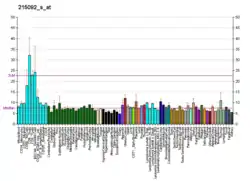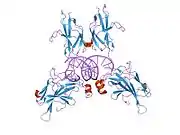NFAT5
Nuclear factor of activated T-cells 5, also known as NFAT5, is a human gene that encodes a transcription factor that regulates the expression of genes involved in the osmotic stress.[5]
The product of this gene is a member of the nuclear factors of activated T cells (NFAT) family of transcription factors. Proteins belonging to this family play a central role in inducible gene transcription during the immune response. This protein regulates gene expression induced by osmotic stress in mammalian cells. Unlike monomeric members of this protein family, this protein exists as a homodimer and forms stable dimers with DNA elements. Multiple transcript variants encoding different isoforms have been found for this gene.[5]
Osmotic stress
Tissues that comprise the kidneys, skin, and eyes are often subjected to osmotic stresses. When the extracellular environment is hypertonic, cells lose water and consequently, shrink. To counteract this, cells increase their sodium uptake in order to lose less water. However, an increase in intracellular ionic concentration is harmful to the cell. Cells can alternatively synthesize enzymes and transporters that increase intracellular concentration of organic osmolytes, which are less toxic than excess ions but which also aid in water retention. Under conditions of hyperosmolarity, NFAT5 is synthesized and accumulates in the nucleus. NFAT5 stimulates the transcription of genes for aldose reductase (AR), the sodium chloride-betaine cotransporter (SLC6A12) the sodium/myo-inositol cotransporter (SLC5A3), the taurine transporter (SLC6A6) and neuropathy target esterase which are involved in the production and uptake of organic osmolytes.[6][7] Additionally, NFAT5 induces heat shock proteins, Hsp70, and osmotic stress proteins. NFAT5 is also implicated in cytokine production.[8]
It has been shown that when NFAT5 is inhibited in renal and immune cells, these cells become significantly more susceptible to osmotic stress. NFAT5 deficient mice were found to suffer from massive cell loss in the renal medulla.[9] Additionally, mice expressing a dominant-negative form of NFAT5 in their eyes exhibited decreased viability under hypertonic extracellular environment.[10]
Structure
The NFAT family consists of five different forms: NFAT1, NFAT2, NFAT3, NFAT4, and NFAT5 (this protein). The proteins in this family are expressed in nearly every tissue in the body and are known transcriptional regulators in cytokine and immune cell expression. Among the different forms of NFAT, NFAT5 is an important component of the hyperosmolar stress response system.[8] cDNA of NFAT5 was first isolated from a human brain cDNA library. Subsequent analysis revealed that NFAT5 is a member of the Rel family, which also consists of NF-κB and NFATc proteins. The largest Rel protein, it consists of nearly 1,500 amino acid residues. Like the other Rel proteins, NFAT5 contains the Rel homology domain, a conserved DNA-binding domain. Outside of the Rel homology domain, no similarities exist between NFAT5 and NF-κB or NFATc. Among these differences is the absence of docking sites for calcineurin, which is necessary for NFATc nuclear import.[11] Instead, NFAT5 is a constitutively nuclear protein whose activity and localization does not depend on calcineurin-mediated dephosphorylation.[8][11] Increased NFAT5 transcription is correlated with p38 MAPK-mediated phosphorylation.

Mechanism of Activation
Although the precise mechanism by which osmotic stress is sensed by the cell is unclear, it has been suggested that Brx, a guanine nucleotide exchange factor (GEF) localized near the plasma membrane, is activated by osmotic stress through changes in the cytoskeleton structure. Alternatively, Brx may also be activated through changes in its interactions with possible osmosensor molecules at the cell membrane.[12] Upon Brx activation, the GEF domain of Brx facilitates activation of Rho-type small G proteins from its inactive GDP state to active GTP state. Additionally, activated Brx also recruits and physically interacts with JIP4, a p38 MAPK-specific scaffold protein. JIP4 binds to downstream kinases, MKK3 and MKK6.[13] This complex then activates p38 mitogen-activated protein kinase (MAPK). Activation of p38 MAPK is regulated by Cdc42 and Rac1. Activation of p38 MAPK is a necessary step for NFAT5 expression.[12]
It has been found that NFAT5 expression, following hyperosmolarity, depends on p38 mitogen-activated protein kinase (MAPK). The addition of a p38 MAPK inhibitor was found to correlate with decreased NFAT5 expression, even in the presence of osmotic stress signals.[9] However, the downstream transcription of the NFAT5 gene by p38 MAPK is currently not yet characterized. It is hypothesized that p38 MAPK phosphorylation activates c-Fos and interferon regulatory factors (IRFs), which bind to AP-1-binding sites and ISRES (Interferon Stimulated Response Element) respectively. Binding to these sites consequently activates the transcription of target genes.[12]
Although the Brx-mediated activation of NFAT5 has only been examined in lymphocyte response to osmotic stress, it is hypothesized that this mechanism is a common one in other cell types.
Additional Roles
NFAT5 has also been implicated in other biological roles, such as in embryonic development. Mice in the embryonic stages with non-function NFAT5 exhibited reduced survivorship.
NFAT5 is also involved in cellular proliferation. NFAT5 mRNA expression is particularly high in proliferating cells. Inhibition of NFAT5 in embryonic fibroblasts resulted in cell cycle arrest.[8]
Although NFAT5 has been found to be important in other biological processes besides hyperosmotic stress response, the mechanism by which NFAT5 acts in these other processes are currently not well known.
References
- GRCh38: Ensembl release 89: ENSG00000102908 - Ensembl, May 2017
- GRCm38: Ensembl release 89: ENSMUSG00000003847 - Ensembl, May 2017
- "Human PubMed Reference:". National Center for Biotechnology Information, U.S. National Library of Medicine.
- "Mouse PubMed Reference:". National Center for Biotechnology Information, U.S. National Library of Medicine.
- "Entrez Gene: NFAT5 nuclear factor of activated T-cells 5, tonicity-responsive".
- Lee SD, Choi SY, Lim SW, Lamitina ST, Ho SN, Go WY, Kwon HM (2011). "TonEBP stimulates multiple cellular pathways for adaptation to hypertonic stress: Organic osmolyte-dependent and -independent pathways". AJP: Renal Physiology. 300 (3): F707–F715. doi:10.1152/ajprenal.00227.2010. PMC 3064130. PMID 21209002.
- Miyakawa H, Woo SK, Dahl SC, Handler JS, Kwon HM (1999). "Tonicity-responsive enhancer binding protein, a Rel-like protein that stimulates transcription in response to hypertonicity". Proc Natl Acad Sci USA. 96 (5): 2538–2542. Bibcode:1999PNAS...96.2538M. doi:10.1073/pnas.96.5.2538. PMC 26820. PMID 10051678.
- Lee JH, Kim M, Im YS, Choi W, Byeon SH, Lee HK (2008). "NFAT5 induction and its role in hyperosmolar stressed human limbal epithelial cells". Invest. Ophthalmol. Vis. Sci. 49 (5): 1827–1835. doi:10.1167/iovs.07-1142. PMID 18436816.
- López-Rodríguez C, Antos CL, Shelton JM, Richardson JA, Lin F, Novobrantseva TI, Bronson RT, Igarashi P, Rao A, Olson EN (February 2004). "Loss of NFAT5 results in renal atrophy and lack of tonicity-responsive gene expression". Proc. Natl. Acad. Sci. U.S.A. 101 (8): 2392–7. Bibcode:2004PNAS..101.2392L. doi:10.1073/pnas.0308703100. PMC 356961. PMID 14983020.
- Wang Y, Ko BC, Yang JY, Lam TT, Jiang Z, Zhang J, Chung SK, Chung SS (May 2005). "Transgenic mice expressing dominant-negative osmotic-response element-binding protein (OREBP) in lens exhibit fiber cell elongation defect associated with increased DNA breaks". J. Biol. Chem. 280 (20): 19986–91. doi:10.1074/jbc.M501689200. PMID 15774462.
- Lopez-Rodríguez C, Aramburu J, Rakeman AS, Rao A (June 1999). "NFAT5, a constitutively nuclear NFAT protein that does not cooperate with Fos and Jun". Proc. Natl. Acad. Sci. U.S.A. 96 (13): 7214–9. Bibcode:1999PNAS...96.7214L. doi:10.1073/pnas.96.13.7214. PMC 22056. PMID 10377394.
- Kino T, Takatori H, Manoli I, Wang Y, Tiulpakov A, Blackman MR, Su YA, Chrousos GP, DeCherney AH, Segars JH (2009). "Brx mediates the response of lymphocytes to osmotic stress through the activation of NFAT5". Sci Signal. 2 (57): ra5. doi:10.1126/scisignal.2000081. PMC 2856329. PMID 19211510.
- Kelkar N, Standen CL, Davis RJ (April 2005). "Role of the JIP4 scaffold protein in the regulation of mitogen-activated protein kinase signaling pathways". Mol. Cell. Biol. 25 (7): 2733–43. doi:10.1128/MCB.25.7.2733-2743.2005. PMC 1061651. PMID 15767678.
Further reading
- López-Rodríguez C, Aramburu J, Rakeman AS, et al. (2001). "NF-AT5: the NF-AT family of transcription factors expands in a new direction". Cold Spring Harb. Symp. Quant. Biol. 64 (1): 517–26. doi:10.1101/sqb.1999.64.517. PMID 11233530.
- Horsley V, Pavlath GK (2002). "NFAT: ubiquitous regulator of cell differentiation and adaptation". J. Cell Biol. 156 (5): 771–4. doi:10.1083/jcb.200111073. PMC 2173310. PMID 11877454.
- Nagase T, Ishikawa K, Suyama M, et al. (1999). "Prediction of the coding sequences of unidentified human genes. XII. The complete sequences of 100 new cDNA clones from brain which code for large proteins in vitro". DNA Res. 5 (6): 355–64. doi:10.1093/dnares/5.6.355. PMID 10048485.
- Miyakawa H, Woo SK, Dahl SC, et al. (1999). "Tonicity-responsive enhancer binding protein, a rel-like protein that stimulates transcription in response to hypertonicity". Proc. Natl. Acad. Sci. U.S.A. 96 (5): 2538–42. Bibcode:1999PNAS...96.2538M. doi:10.1073/pnas.96.5.2538. PMC 26820. PMID 10051678.
- Lopez-Rodríguez C, Aramburu J, Rakeman AS, Rao A (1999). "NFAT5, a constitutively nuclear NFAT protein that does not cooperate with Fos and Jun". Proc. Natl. Acad. Sci. U.S.A. 96 (13): 7214–9. Bibcode:1999PNAS...96.7214L. doi:10.1073/pnas.96.13.7214. PMC 22056. PMID 10377394.
- Zühlke C, Kiehl R, Johannsmeyer A, et al. (2000). "Isolation and characterization of novel CAG repeat containing genes expressed in human brain". DNA Seq. 10 (1): 1–6. doi:10.3109/10425179909033929. PMID 10565538.
- Ko BC, Turck CW, Lee KW, et al. (2000). "Purification, identification, and characterization of an osmotic response element binding protein". Biochem. Biophys. Res. Commun. 270 (1): 52–61. doi:10.1006/bbrc.2000.2376. PMID 10733904.
- Trama J, Lu Q, Hawley RG, Ho SN (2000). "The NFAT-related protein NFATL1 (TonEBP/NFAT5) is induced upon T cell activation in a calcineurin-dependent manner". J. Immunol. 165 (9): 4884–94. doi:10.4049/jimmunol.165.9.4884. PMID 11046013.
- Hebinck A, Dalski A, Engel H, et al. (2000). "Assignment of transcription factor NFAT5 to human chromosome 16q22.1, murine chromosome 8D and porcine chromosome 6p1.4 and comparison of the polyglutamine domains". Cytogenet. Cell Genet. 90 (1–2): 68–70. doi:10.1159/000015665. PMID 11060450. S2CID 26169461.
- López-Rodríguez C, Aramburu J, Jin L, et al. (2001). "Bridging the NFAT and NF-kappaB families: NFAT5 dimerization regulates cytokine gene transcription in response to osmotic stress". Immunity. 15 (1): 47–58. doi:10.1016/S1074-7613(01)00165-0. PMID 11485737.
- Dalski A, Schwinger E, Zühlke C (2001). "Genomic organization of the human NFAT5 gene: exon-intron structure of the 14-kb transcript and CpG-island analysis of the promoter region". Cytogenet. Cell Genet. 93 (3–4): 239–41. doi:10.1159/000056990. PMID 11528118. S2CID 20758948.
- Stroud JC, Lopez-Rodriguez C, Rao A, Chen L (2002). "Structure of a TonEBP-DNA complex reveals DNA encircled by a transcription factor". Nat. Struct. Biol. 9 (2): 90–4. doi:10.1038/nsb749. PMID 11780147. S2CID 20918812.
- Ferraris JD, Williams CK, Persaud P, et al. (2002). "Activity of the TonEBP/OREBP transactivation domain varies directly with extracellular NaCl concentration". Proc. Natl. Acad. Sci. U.S.A. 99 (2): 739–44. Bibcode:2002PNAS...99..739F. doi:10.1073/pnas.241637298. PMC 117375. PMID 11792870.
- Merante F, Altamentova SM, Mickle DA, et al. (2002). "The characterization and purification of a human transcription factor modulating the glutathione peroxidase gene in response to oxygen tension". Mol. Cell. Biochem. 229 (1–2): 73–83. doi:10.1023/A:1017921110363. PMID 11936849. S2CID 24302120.
- Ko BC, Lam AK, Kapus A, et al. (2003). "Fyn and p38 signaling are both required for maximal hypertonic activation of the osmotic response element-binding protein/tonicity-responsive enhancer-binding protein (OREBP/TonEBP)". J. Biol. Chem. 277 (48): 46085–92. doi:10.1074/jbc.M208138200. PMID 12359721.
- Kneitz C, Goller M, Tony H, et al. (2002). "The CD23b promoter is a target for NF-AT transcription factors in B-CLL cells". Biochim. Biophys. Acta. 1588 (1): 41–7. doi:10.1016/s0925-4439(02)00114-x. PMID 12379312.
- Nakayama M, Kikuno R, Ohara O (2003). "Protein-protein interactions between large proteins: two-hybrid screening using a functionally classified library composed of long cDNAs". Genome Res. 12 (11): 1773–84. doi:10.1101/gr.406902. PMC 187542. PMID 12421765.
External links
- NFAT5+protein,+human at the US National Library of Medicine Medical Subject Headings (MeSH)
- Overview of all the structural information available in the PDB for UniProt: O94916 (Nuclear factor of activated T-cells 5) at the PDBe-KB.
This article incorporates text from the United States National Library of Medicine, which is in the public domain.







